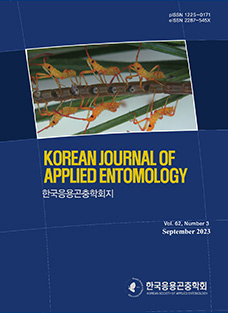In Korea, species belonging to the genus Harmonia Mulsant, 1846 have been recognized as three species, Harmonia axyridis (Pallas, 1773), H. quadripunctata (Pontoppidan, 1763), and H. yedoensis (Takizawa, 1917) (Hong, 2021). Among them, H. quadripunctata was first reported based on a specimen, which is collected from Sun-an, Pyong-an-nam-do province, North Korea in 1965, by Bielawski (1980), and then this species has not been reported by anyone from Korea. The other two species, H. axyridis and H. yedoensis, are recognized to be abundantly occurred in Korean fauna (Park, personal communication). In 2008 and 2022, the authors collected and examined several specimens of H. dimidiata (Fabricius, 1781) in Is. Chuja, Gwangyang-si, and Is. Jeju of southern part of Korea. We therefore report H. dimidiata as a new to Korean fauna. Key to species, diagnosis, and DNA barcoding data of the Korean Harmonia species are given.
Materials and Methods
A total of five specimens of Harmonia dimidiata were collected from Is. Chuja in 2008, Gwangyang-si, Jeollanam-do, Jocheon-up, Is. Jeju in 2022. Each material was examined under the stereoscopic microscope (Leica S8APO; Leica, Solms, Germany) for general morphological structures. To take photo- graphs, Canon EOS D30 and 14.2 color mosaic digital camera system are used. We performed DNA barcoding analysis on a single one of five morphologically identical specimens to represent molecular species identification. This analysis using COI gene sequences is useful to clarify the species statuses of the focal taxon by providing intra- and interspecific divergence (Hajibabaei et al., 2007). Genomic DNA was isolated from a leg using a QIAamp DNA Mini Kit (Qiagen, Hilden, Germany). PCR was performed using AccuPower Profi Taq PCR Premix (Bioneer, Daejoen, Korea) with the universal primer set LCO 1490/HCO2198 (Folmer et al., 1994). The PCR conditions, processing of PCR amplicons, sequencing, and checking for co-amplified paralogous sequences and contaminants were followed in Han et al. (2019). The generated COI sequence of the Korean specimen of Harnomia dimidiata is available in GenBank (http://www.ncbi.nlm.nih.gov/genbank) under accession number PV545334. For comparative analyses, 12 COI sequences for species of Harmonia, Aphidecta and Hippodamia were downloaded from GenBank as following: MN940447, KU917400, MW551383, EF192096, MW551381, MT935586, KY838270, MW392901, PQ056543, CN14974, JF889849, and OL663100. After our examination, the three specimens are preserved at Cultural Entomology Institute (CEI) and two specimens are stored at Nakdonggang National Institute of Biological Resources (NNIBR).
Results
Key to species of genus Harmonia in Korea
-
1. Body elongate oval; body length 5.0~7.5 mm, not exceeding over 8.0 mm ························································· 2
-
- Body nearly round; body length 7.4~10.0 mm, not smaller than 7.0 mm; each elytron with seven black spots (1-3-2-1) ·················································· H. dimidiata (Fabricius)
-
2. Prosternal process without carinae; pronotum with 11 small black dots; each elytron with eight black spots (1-3-3-1); body rather small, 5.0~6.5 mm ····················· ·································· H. quadripunctata (Pontoppidan)
-
- Prosternal process with carinae; pronotal and elytral coloration variable; length 5.8~7.5 mm ························ 3
-
3. Elytra with transverse fold at apical declivity ················ ························································ H. axyridis (Pallas)
-
- Elytra without transverse fold at apical declivity ············· ················································· H. yedoensis (Takizawa)
Taxonomic accounts
Family Coccinellidae Latreille, 1807 무당벌레과
Subfamily Coccinellinae Latreille, 1807 무당벌레아과
Tribe Coccinellini Weise, 1885 무당벌레족
Genus Harmonia Mulsant, 1846
Type-species: Harmonia dimidiata (Fabricius, 1781) [Coromandel]
Harmonia dimidiata (Fabricius, 1781) 남방큰무당벌레(신칭)
Coccinella dimidiataFabricius, 1781: 94,
Coccinella dimidiaHope, 1831: 30.
Leis dimidiataMulsant, 1850: 242.
Coccinella quindecimmaculataHope, 1831: 30.
Coccienlla quindecimspilotaHope, 1831: 30.
Coccinella bicolorHope, 1831: 31.
Harmonia dimidiata: Miyatake, 1965: 62.
Diagnosis. Body large, 7.0~10.0 mm in length, strongly oval and convex, reddish orange, strongly shiny (Fig. 1). Head wider than long, posterior and lateral margins black; eye black. Pronotum with black bilobed spot posteriorly. Scutellum black. Elytra with 13 black spots; each elytron seven spots arranged in 1-3-2-1 pattern (Fig. 2A). Prosternal process carinae distinct, narrowed anteriorly (Fig. 2B and 2C).
Variation. Variants of H. dimidiata are known as four polymorphic forms: 1) without pronotal spots, 2) with macula on pronotum, 3) with enlarged spots, 4) without pronotal and elytral spots in India (see Poorani and Booth, 2016). The other hand, more than five morphs are recognized in Nepal (Miyatake, 1985).
DNA barcoding. A dataset was consisted to 16 COI sequences of six species of Harmonia, one species of Aphidecta and Hippodamia, respectively. The later two genera were treated as outgroup taxa. In a Neighbor-joining (NJ) analysis (Fig. 3), the Korean specimen showed clustering with other geographical populations of H. dimidiata, it is clearly indicated they are conspecific. However, intraspecific genetic distance is a little different range from 0.9 to 1.2% between The Korean papulation and the other local populations.
Examined specimens. 1♀, Mt. Dondae, Chuja-myeon, Is Chuja, Jeju-do, Korea. 9. vii. 2008. H. Park and T. Han; 2♀♀, Golyak-dong, Gwangyang-si, Jeollanam-do, Korea. 1. vii. 2022. Y. H. Pack; 2♀♀ (NNIBR2022552INI12607, NNIBR202255 21INI2608), Samdasu-gil, san 70-2, Gyeorae-ri, Jocheon-eup, Jeju-si, Jeju-do, Korea. 25. vii. 2022. S. H. Jeong.
Distribution. Korea (new record), India, Pakistan, Nepal, Bhutan, China, Japan, Taiwan, introduced a Chinese population into North America in 1925 (Poorani, 2002;Frank and McCoy, 2007) and also into the Russian Caucasus for control of aphids (Semyanov, 1999;Bieńkowski, 2018).
Remarks. This greater Asian lady beetle, H. dimidiata, has well known to be distributed in East Asia region (Poorani, 2002). For discovery of this species in Korea, we consider that the species may be naturally dispersed from other countries of South eastern Asia and settled down in southern part of Korea, because all examined specimens were separately collected at natural fields in the southern extreme areas of the Korean Peninsula since 2000. Therefore, a study on the Korean population of the species will be needed in the view point of population delimitation to compare with other country populations and the effects of ecological competitions between their congeners.












 KSAE
KSAE





